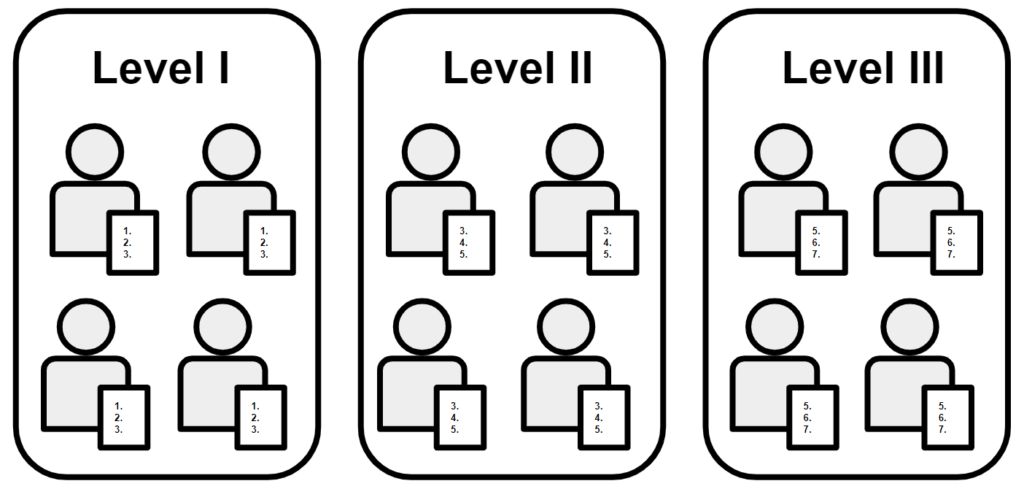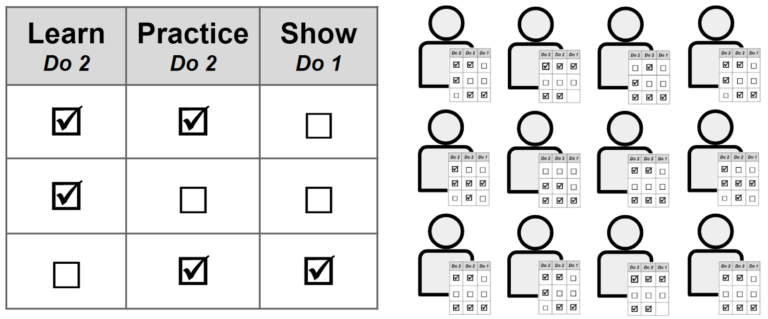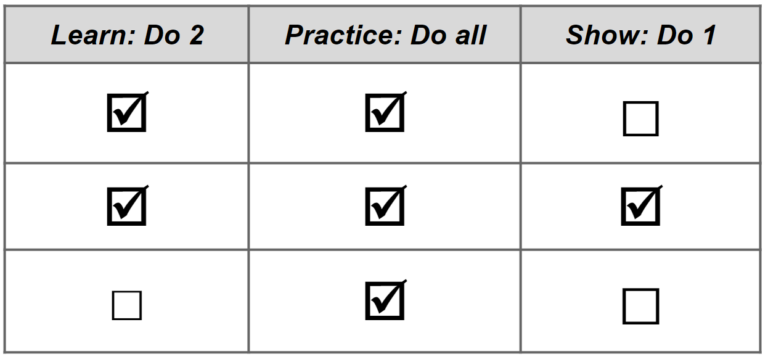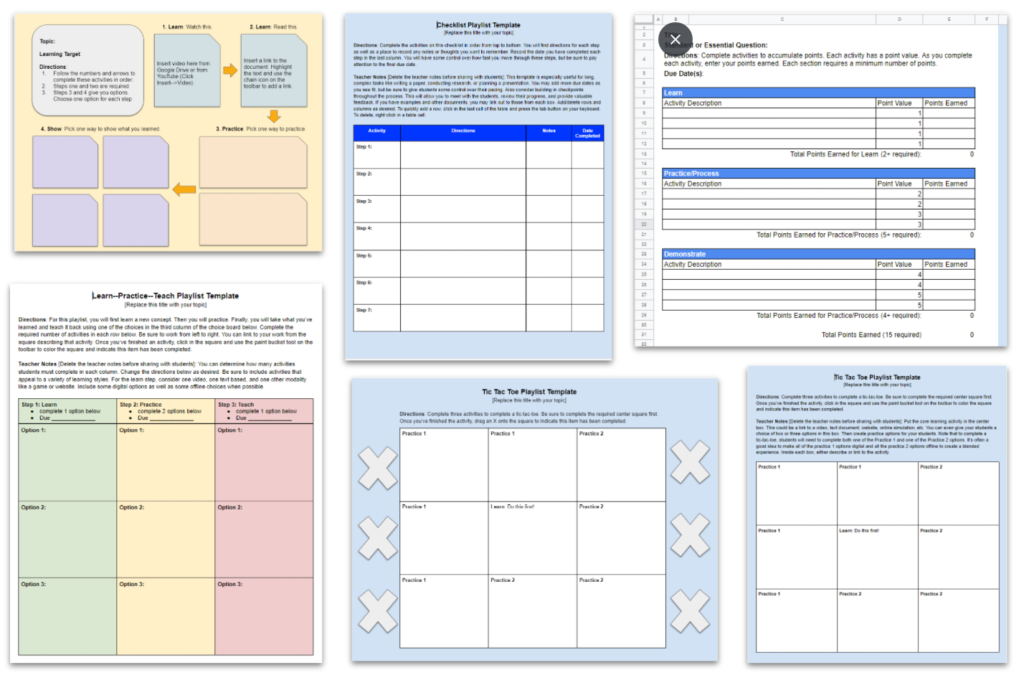The playlist is a very flexible blended learning model, and like station rotation and flipped learning, playlists are often used in conjunction with other blended learning models.
Like these other models, playlists need to contain some element of online learning and some learning that is offline in order to be considered “blended.” These online and offline experiences should be aligned and work together to support a common academic standard or learning objective.
Three Types of Playlists
The playlist model is derived from the “individual rotation” model outlined by Blended Learning Universe, which is curated by the Christensen Institute, and by Michael B. Horn and Heather Staker in their book, Blended: Using Disruptive Innovation to Improve Schools. In this model, students are given lists of learning experiences that are customized to meet their unique learning needs. In blended learning, these lists are called playlists, which can be generated by the teacher or a computer algorithm.
There are three common variations of this model:
1. Single-Path Playlists
With this model, the playlist is a sequential list of tasks and learning experiences that each student is expected to complete in order to achieve a learning outcome.
In the gold-standard version of a single-path playlist, every student would have their own, customized learning path that aligns with their unique learning styles and academic needs. Some classrooms have access to software programs that can assess, diagnose learning needs, and assign these individualized learning pathways. These robust programs can make the creation of personalized playlists very efficient.
While AI is beginning to make computer-assisted playlists more common and financially accessible, most playlists are still created manually by the teacher. Since the creation of playlists can take an enormous amount of time, teachers are often unable to create a unique version for each student. Instead, they create several versions that will meet most learner needs (developing, at standard, and above standard), and they then assign them to groups of students to provide differentiated instruction. Despite not being individualized to each student, this approach is still a significant improvement from “one size fits all” lessons.

2. Choice-Board Playlists
In the single-path playlist, the teacher or computer algorithm decides what learning tasks students will complete. In the choice-board playlist, however, students are allowed some voice and choice in selecting their own learning pathway.
As the teacher, you will create at least two different pathways of experiences that will guide your students to proficiency toward an academic goal. At designated points in the learning pathway, you provide students with options to choose from. This allows them to find the path that best matches their learning styles and empowers them throughout the learning process.
While students have considerable choice in a playlist, it’s important to note that these choice boards are not free-for-alls. They are intentionally structured, so students will experience all the critical learning regardless of which path they choose. Choice boards offer both structure and choice for students.

3. A Blend of Single Path and Choice Boards
In this approach, teachers provide “must do” and “may do” activities. The “must dos” are required and ensure that all students experience the same core instruction or practice. The “may dos” provide choice and allow students to customize the remainder of the learning to meet their unique needs and styles.
In some cases, teachers require all activities to be completed for key steps in the process. For other stages in the learning journey, students must complete a defined number of tasks within a required step in the process. In this way, the playlist experience is both fixed and flexible.
For instance, there might be a “learn” stage where the student can choose to read about a concept, watch a video, or experience a simulation. Students must complete the “learn” stage, but they have a voice as to which path works best for them. Similarly, students may have choice in how they process, practice, or demonstrate the learning.

The Benefits of the Playlist Model
There are multiple advantages to using a playlist model:
- Student control
As with the other blended learning models, playlists provide students with some degree of control over the pace, place, path, and time of their learning. This is empowering and puts the students in the driver’s seat. When students own their learning, they are more apt to stay engaged in it and take responsibility for the results. It becomes something “they are choosing to do” rather than something that is “done to them.” In every playlist, students should experience some degree of choice.
- Personalization
Personalization is related to student control, but it goes further. Students are not all the same; they each learn differently, have varied interests, are at different stages in the learning process, and are uniquely motivated. Playlists provide us with an opportunity to personalize the learning experience to better meet the unique needs of each student. In the single-path playlist, the teacher can personalize instruction to meet individual learning needs. In the choice-board playlist, students can choose options that are motivating and meet their learning styles.
- An increase in individualized teacher time
Because students can work through their playlists largely on their own, you are freed up to meet with individual students. Sometimes, these meetings are built into the playlist. For instance, step three might be a teacher meeting. When students get to this part of the playlist, they come and meet with you. In other cases, you can move about the room and check in with students as you see fit. When combined with station rotation, students can complete their playlist at one of the stations, while another station can be the face-to-face teacher station.
How Do I Design My Playlist?
If you decide that the playlist approach is right for your students, following this five-step process can help guide you through the playlist creation process:
1. Identify your learning outcome.
This is always where you should begin. Everything that you design for your playlist should help guide students toward proficiency in the designated learning standard. In conjunction with this learning target, consider how you will want your students to demonstrate their learning. Your playlist should be designed as a pathway toward this outcome, and everything in it should be aligned to this learning goal.
2. Identify the necessary steps in the learning experience.
Because students will be working through their playlist mostly on their own, you will want to organize the learning tasks in a way that will be easy to understand and navigate. Here are a few popular frameworks that you can use to organize your playlist. Notice how they are simple to grasp and can be used to frame choices in the learning process:
- Learn It–Practice It–Teach It
- Learn–Process–Demonstrate
- Learn–Create–Show
- Engage–Explore–Explain
- Watch–Read–Make
3. Decide if you will use a single-path playlist or choice-board playlist.
Both of these options can be effective and have their advantages. As you make your choice, consider your needs, the needs of your students, and how much time you have available to create your playlists. Single-path playlists are faster to create but provide fewer opportunities for student choice.
4. Choose a format.
This is where you can have some fun and be creative. You might gamify the experience by designing your playlist as a bingo or tic-tac-toe board. You could design the activities so that students need to earn a certain number of points to complete their board. In some cases, you might empower the students to learn about a concept, practice it, and then become the teacher to demonstrate what they’ve learned. The choice is yours!
AVID Open Access has created a set of free templates to help you get started. If you like one of these options, click the link, choose “File,” and select “Make a copy” to create an editable version for your use:
- Learn–Practice–Teach (Google Docs)
- Tic–Tac–Toe (Google Slides; Google Docs)
- Earn Points (Google Sheets)
- Longer, Sequential Task Checklist (Google Docs)
- Visual Path (Google Slides)
- Watch–Read–Make (Google Slides)
 If you prefer Microsoft products, you can select “File” and then scroll over “Download” to select your desired platform, such as Word or PowerPoint. These templates can serve as a convenient starting point to designing your first playlist.
If you prefer Microsoft products, you can select “File” and then scroll over “Download” to select your desired platform, such as Word or PowerPoint. These templates can serve as a convenient starting point to designing your first playlist.
There are many ways to format your playlist. Editable documents, slideshows, and spreadsheets all work very well and allow you to embed hyperlinks, images, and other media.
5. Develop the learning activities.
This is a key part of the process. You will need to design the learning activities so that students can learn and become proficient in the outcomes you’ve selected. It is essential that if students are given choice, every path they might choose will lead them toward your outcome. Think of it as a “choose your own adventure” opportunity for your students, with the key being that they all end up at the same destination: your learning outcome.
AVID Connections
This resource connects with the following components of the AVID College and Career Readiness Framework:
- Instruction
- Rigorous Academic Preparedness
- Student Agency
- Insist on Rigor
- Break Down Barriers
- Align the Work
Extend Your Learning
- Playlists: A Path to Personalizing Learning (Dr. Catlin Tucker)
- Using Playlists to Differentiate Instruction (Jennifer Gonzalez via Cult of Pedagogy)
- Playlist Building 101 (Education Elements)
